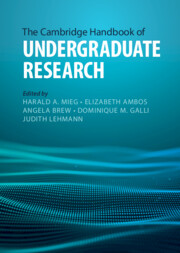Book contents
- The Cambridge Handbook of Undergraduate Research
- The Cambridge Handbook of Undergraduate Research
- Copyright page
- Contents
- Figures
- Tables
- Contributors
- Foreword
- Foreword
- 1 Introduction
- Part I Theory and Research on Undergraduate Research
- Part II Implementation, Approaches, Methods
- Part III Disciplines
- 17 Introduction
- Part III.1 STEM
- Part III.2 Health
- Part III.3 Social Sciences
- Part III.4 Humanities
- 32 Undergraduate Research in History
- 33 Undergraduate Research in English
- 34 Undergraduate Research in Philosophy
- 35 Undergraduate Research in Theology and Religious Studies
- Part III.5 Arts & Design
- Part III.6 Disciplines A–Z
- Part IV International Perspective
- Part V Avenues for Developing Undergraduate Research
- Index
- References
32 - Undergraduate Research in History
Into the Archives: Undergraduate Historians as Good Citizens
from Part III.4 - Humanities
Published online by Cambridge University Press: 11 August 2022
- The Cambridge Handbook of Undergraduate Research
- The Cambridge Handbook of Undergraduate Research
- Copyright page
- Contents
- Figures
- Tables
- Contributors
- Foreword
- Foreword
- 1 Introduction
- Part I Theory and Research on Undergraduate Research
- Part II Implementation, Approaches, Methods
- Part III Disciplines
- 17 Introduction
- Part III.1 STEM
- Part III.2 Health
- Part III.3 Social Sciences
- Part III.4 Humanities
- 32 Undergraduate Research in History
- 33 Undergraduate Research in English
- 34 Undergraduate Research in Philosophy
- 35 Undergraduate Research in Theology and Religious Studies
- Part III.5 Arts & Design
- Part III.6 Disciplines A–Z
- Part IV International Perspective
- Part V Avenues for Developing Undergraduate Research
- Index
- References
Summary
The chapter provides an overview of how undergraduate history students are often introduced to historical research as well as a possible corrective. We offer a new approach, which we believe improves the undergraduate research experience for history students. We claim that the logic of the discipline tends to lead to curricula in which the first years of study are mainly based on secondary texts while sustained interaction with primary sources is often left toward the conclusion of undergraduate studies.At Valparaiso University we implemented a hybrid internship/independent study course in which students work at the University Archives and Special Collections while pursuing historical research projects based on the collections. We believe the course strengthens the connection of students to primary documents and encourages students to conceptualize research as a civic enterprise.
Keywords
- Type
- Chapter
- Information
- The Cambridge Handbook of Undergraduate Research , pp. 313 - 320Publisher: Cambridge University PressPrint publication year: 2022

